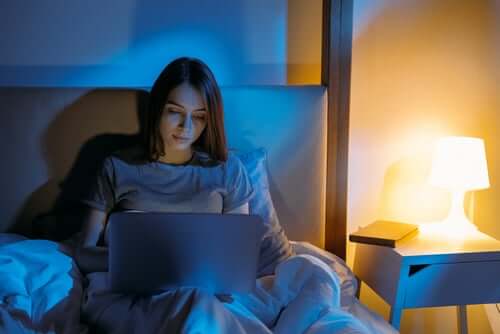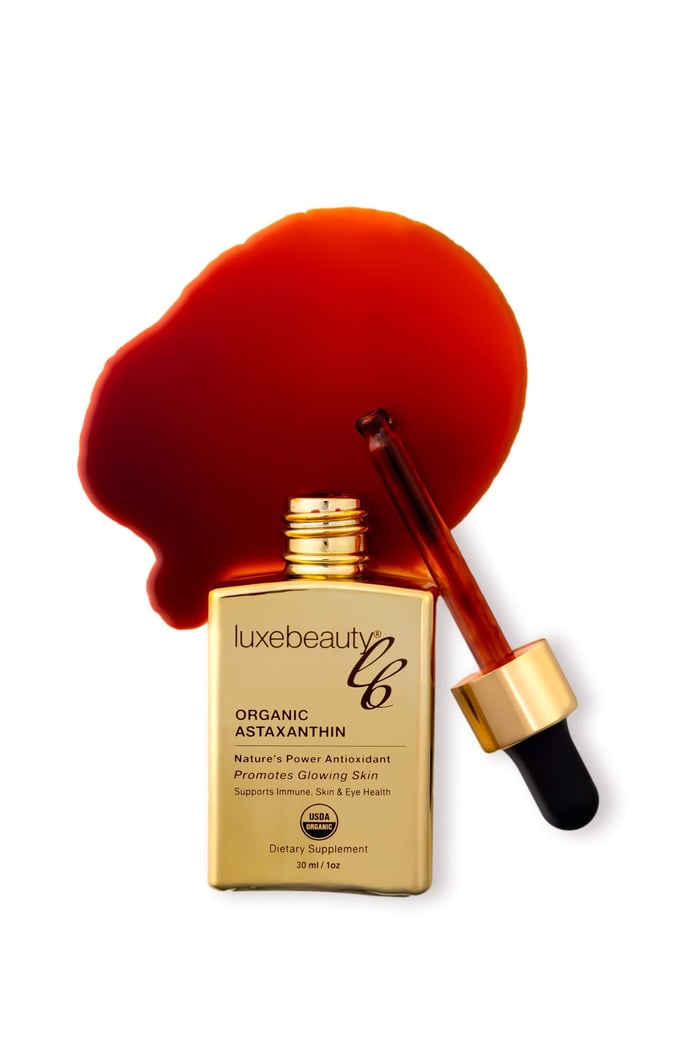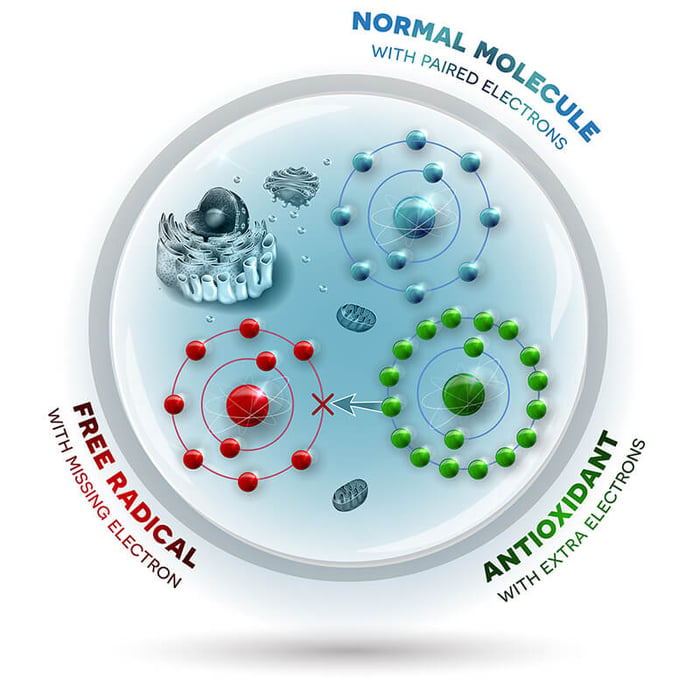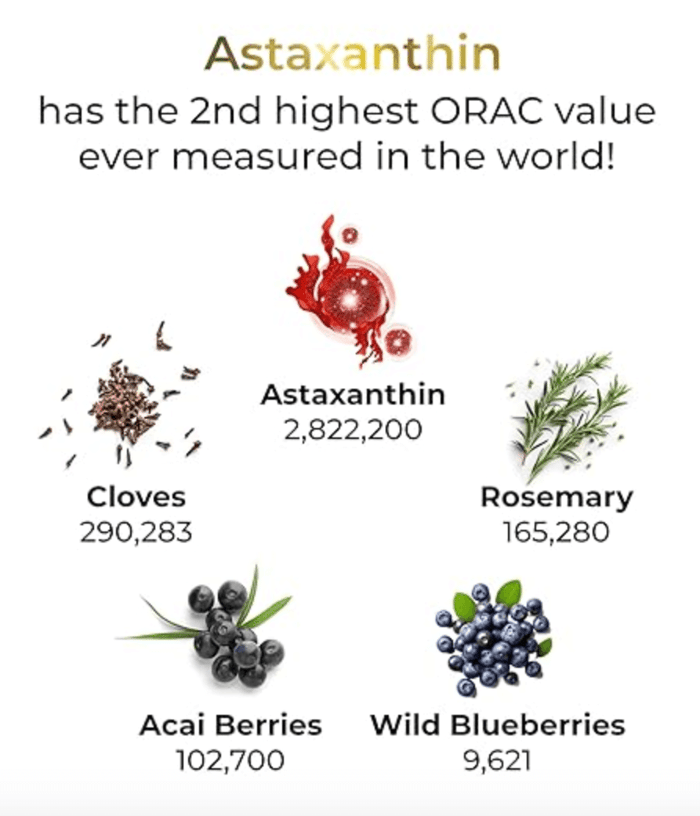Table of Contents
- Understanding Blue Light
- Blue Light vs. UV Light: A Comparative Insight
- Natural vs. Artificial Blue Light: The Balance Matters
- The Flicker Factor: An Overlooked Concern
- The Impact of Blue Light on Skin Health
- Internal Defense: The Skin's Antioxidant Pathway
- Protective Measures Against Blue Light Exposure
- Conclusion
- FAQs
In our digitally-driven world, exposure to screens is nearly constant. While we often consider the impact of screen time on our eyes and sleep, there's a lesser-known adversary at play: blue light's impact on our skin and how blue light accelerates aging and hormones.
Emerging research indicates that blue light, emitted from our devices ( phones, computers, tv screens, LED lighting are accelerating skin aging, disrupting hormonal functions, and hindering skin's natural healing processes. But here’s the truth that’s rarely spoken: your skin has an internal defense system—and it needs your support and I want you to know about it so you can support it.
Understanding Blue Light
Blue light is part of the visible light spectrum, with wavelengths ranging from 400 to 490 nanometers. Blue light is emitted by the sun, but it is balanced with all the other rays and does not flicker. Blue light from artificial sources like smartphones, computers, and LED lights have a flicker ( you cannot see the flicker with your eyes).
Blue Light vs. UV Light: A Comparative Insight
Blue light penetrates the skin DEEPER than UVB and UVA, where collagen and elastin live. Therefore, blue impacts skin collagen and elastic health. Prolong expsosure to blue light leads to oxidative stress, inflammation and premature aging. (Read the study - PMC).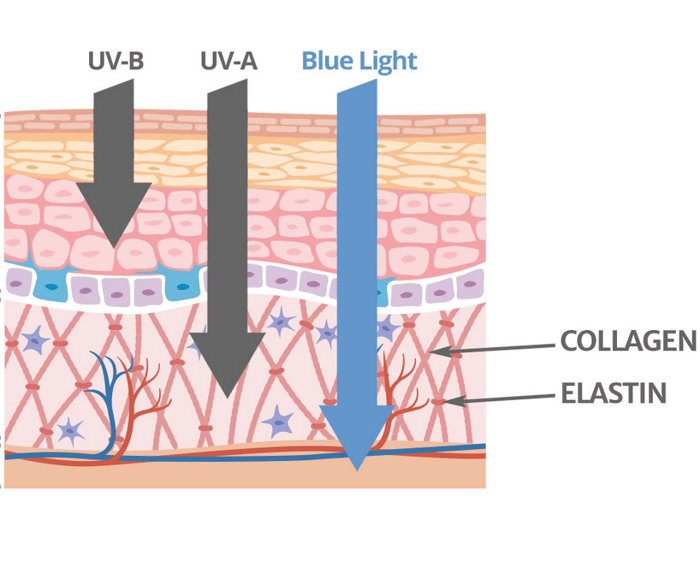
Natural vs. Artificial Blue Light: The Balance Matters
Sunlight, our natural source of blue light, is a full-spectrum light that includes a balance of various wavelengths—blue, red, green, and infrared. This balance is crucial; red and near-infrared light, for instance, have been shown to counteract some of the oxidative stress induced by blue light, promoting skin healing and reducing inflammation.
In contrast, artificial sources like LED lights ( street lights, All the new Light bulbs, car lights) screens ( phone, computer, TV) emit a disproportionate amount of blue light with minimal red or infrared wavelengths. This imbalance can lead to increased oxidative stress on the skin, as the mitigating effects of other wavelengths are absent.
The Flicker Factor: An Overlooked Concern
Beyond the spectrum imbalance, artificial lighting often introduces another issue: flicker. Many LED lights and screens flicker at high frequencies, imperceptible to the naked eye but potentially disruptive to biological systems. This flickering can contribute to eye strain, headaches, and may exacerbate the skin's exposure to oxidative stress by causing micro-fluctuations in light intensity.
Flickering from artificial lights, such as LEDs, can have various biological effects, including headaches and visual disturbances (Read the study - PMC).
Exposure to 40 Hz light flicker can alter human brain electroencephalography, indicating neurological effects (Read the study - PMC).
Flickering LED lights are associated with dizziness, headaches, and stress, posing health risks (Read the study - PMC).
💡 Luxe Beauty Tip: Replace all LED lighting with incandescent bulbs. Incandescent lights don’t emit blue light, don’t flicker, and are biologically harmonious with your skin and hormones.
The Impact of Blue Light on Skin Health
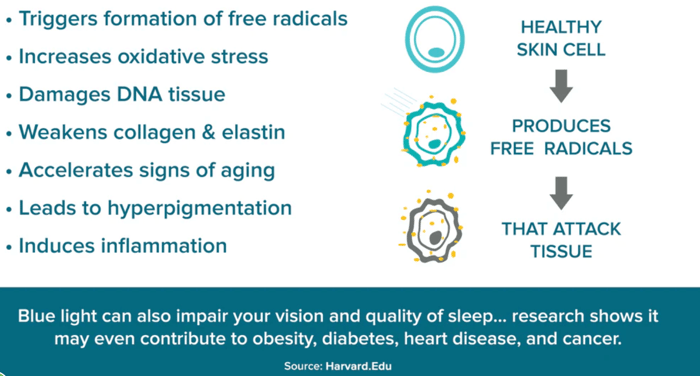
1. Accelerated Skin Aging
Exposure to blue light has been linked to the generation of reactive oxygen species (ROS) in the skin. These ROS can damage cellular structures, leading to signs of aging such as wrinkles and loss of elasticity.
Blue light exposure can produce oxidative stress in live skin, leading to potential skin damage (Read the study - PubMed).
Exposure to blue light leads to oxidative stress in human skin cells, contributing to skin aging (Read the study - PMC).
High-energy visible light, including blue light, induces oxidative stress in the skin, emphasizing the need for protective measures (Read the study - PMC).
2. Disruption of Skin Healing and Rejuvenation
Blue light exposure may impair the skin's natural repair mechanisms. By inducing oxidative stress, it can interfere with the function of fibroblasts, the cells responsible for producing collagen and elastin, essential for skin's resilience and healing.
3. Hormonal Disruption
Beyond skin-deep effects, blue light can influence hormonal balance. One major issue? It spikes cortisol.
Cortisol, your body's primary stress hormone, should follow a gentle rhythm—rising in the morning, tapering off at night. But exposure to blue light at night tricks your brain into thinking it’s daytime, leading to unnatural surges in cortisol. Elevated nighttime cortisol disrupts sleep, impairs skin healing, and contributes to accelerated aging.
Research results suggest that exposure to blue light and the duration of exposure induced earlier puberty in female rats. As the duration of blue light exposure increased, PCO-like inflammation, and apoptosis were detected in the ovaries." https://pmc.ncbi.nlm.nih.gov/articles/PMC10683537/
Exposure to blue light from LEDs can suppress melatonin production in humans, affecting sleep and circadian rhythms (Read the study - PubMed).
Blue light exposure before bedtime suppresses melatonin and can disrupt sleep patterns (Read the study - PMC).
Artificial light at night, including blue light, can affect mood regulation and brain circuits (Read the study - PMC).
Internal Defense: The Skin's Antioxidant Pathway
Our skin is not defenseless. Deep within, it relies on a built-in antioxidant defense pathway designed to neutralize the ROS created by stressors like blue light. But in today’s world—where we’re bombarded by blue light for hours a day—our natural systems are overwhelmed.
This is where exogenous antioxidants come in.Exogenous antioxidants can work synergistically with our body's naturally produced (endogenous) antioxidants to enhance our overall defense against oxidative stress. This is why it crucial to consume high ORAC antioxidants everyday to buid your shield and create your protection. High ORAC (Oxygen Radical Absorbance Capacity) foods are considered to have a more robust antioxidant capacity, which means they are better at neutralizing free radicals, resulting in greater antioxidant power. Below are some antioxidants ORAC values so you can see that Organic Astaxanthin and cloves have some of the highest ORAC values on earth!
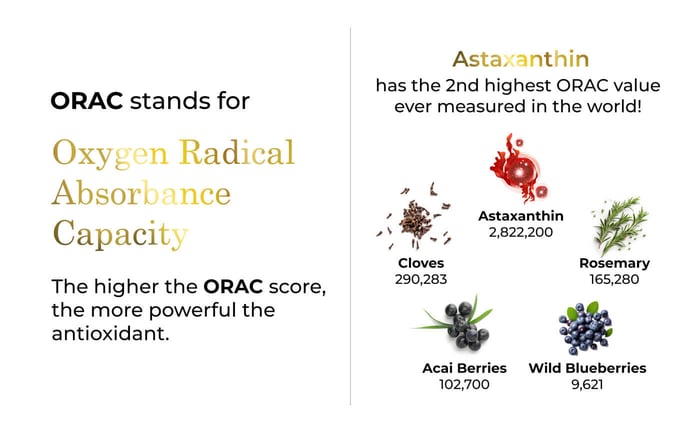
Organic Astaxanthin is nature’s most powerful antioxidant, is 6,000 times stronger than vitamin C. Unlike synthetic options, our organic astaxanthin is lipid-soluble and highly bioavailable, especially when combined with organic olive oil. It integrates directly into the skin’s cellular membranes, fortifying your skin from the inside out. Our Organic astaxanthin Supplement is the purest, most powerful Astaxanthin on the market and made with organic clove and cold press organic olive oil to enhance its power and bio-availability. You must be careful with "Natural" Astaxanthin because it can be grown with nitrates and other synesthetic chemicals.
Astaxanthin doesn’t just fight ROS—it supports mitochondrial function, preserves collagen, and prevents lipid peroxidation in the skin. It helps your skin maintain integrity and elasticity despite constant exposure to digital light.
Supporting your antioxidant defense pathway with daily, bioavailable astaxanthin is no longer optional. In a world ruled by LED light, it’s foundational. High ORAC antiodants likes Organic Astaxanthin promote healthy aging by helping regulate processes involved in aging by protecting against age-related decline in endogenous antioxidant levels
Protective Measures Against Blue Light Exposure
1. Skincare with Antioxidants
Use products high ORAC topical concentrated antioxidants
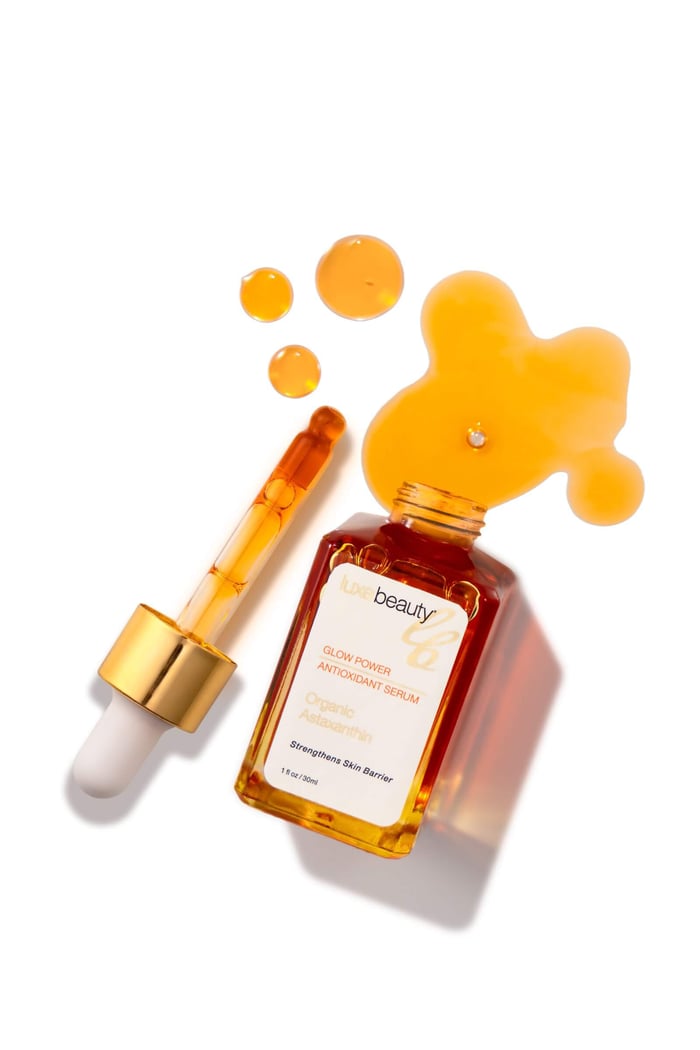
and internal high ORAC antioxidants ( organic astaxanthin and cloves) to neutralize ROS and mitigate oxidative stress induced by blue light. For foundational protection to protect your cells from the inside out, support your body from the inside out with oral antioxidants like certified organic astaxanthin.
3.Why You Should Cover Your Skin Indoors—Not Just Outdoors
Most people think “protecting their skin” means covering up in the sun. But here’s the truth no one talks about:
Your skin often needs more protection indoors—from artificial blue light.
Unlike the balanced, full-spectrum light from the sun, LED and fluorescent lights emit an isolated high-intensity blue wavelength that penetrates deeply into the skin (even deeper than UVB). This blue light triggers oxidative stress, inflammation, and even disrupts mitochondrial and hormonal balance.
If you haven’t yet replaced your LEDs with incandescent bulbs (which emit a warm, natural spectrum that’s gentle on the skin and hormones), a simple way to protect yourself is by covering your skin indoors—especially during evening hours when your body expects darkness.
And it’s not just your skin that needs protection—your eyes do too.
The eyes have direct pathways to the hypothalamus and pineal gland, the brain centers that regulate melatonin, sleep, and hormone balance.
When exposed to blue light at night, your brain thinks it’s daytime, suppressing melatonin, raising cortisol, and throwing off your circadian rhythm.
That’s why wearing blue light–blocking glasses at night (especially under LED or screen exposure) helps restore your natural sleep cycles, lower cortisol, and support skin repair and collagen renewal while you rest.
Think of it as modern “light hygiene.”
Covering your skin and eyes from artificial blue light supports collagen integrity, preserves melatonin production, and helps your skin’s antioxidant defense system reset overnight.
4. Environmental Adjustments
Avoid LED lighting at night. Replace all LED bulbs with incandescent light sources. Incandescent lights do not emit harmful blue light and support healthy hormone production and skin regeneration.
Use full-spectrum, low-flicker lights or candlelight when possible. Prioritize natural light exposure during the day.
5. Digital Hygiene
Turn off screens 1–2 hours before bed. Use blue light filters and apps like f.lux or Night Shift mode. Always blue light blocking glasses at night.
6. To Protect your Eyes
Conclusion
Blue light is more than just a sleep disruptor—it’s a full-body biological stressor. From damaging collagen and inducing wrinkles to suppressing melatonin and harming mood-regulating neurotransmitters like dopamine, artificial blue light is a silent threat in our modern world. By understanding and addressing these dangers—and by fortifying your body with organic astaxanthin—you empower your skin’s biology to thrive.
Stay tuned to Luxe Beauty for more science-backed skincare education and solutions that honor your biology.
FAQs
Does blue light really age your skin?
Yes. Artificial blue light from screens and LEDs penetrates even deeper than UVB rays. It generates oxidative stress, damages collagen and elastin, and can lead to premature wrinkles, pigmentation, and inflammation.
What’s the difference between sunlight and artificial blue light?
Sunlight is full-spectrum—it includes red, infrared, and UV light, which balance each other out. Artificial blue light from LEDs and devices is isolated and intense, lacking the red and infrared wavelengths that repair and counteract damage. That imbalance stresses your skin and disrupts your hormones.
Can blue light affect hormones and sleep?
Absolutely. Blue light from screens and LEDs suppresses melatonin and increases cortisol. This imbalance not only disrupts sleep and mood but also interferes with your skin’s nighttime repair cycle—when collagen renewal and cell regeneration are at their peak.
How can I protect my skin from blue light?
✨ Replace LED and fluorescent bulbs with warm incandescent lighting.
✨ Wear blue light–blocking glasses at night to protect your eyes and hormones.
✨ Cover your skin when exposed to artificial light indoors.
✨ Support your skin’s antioxidant defenses with nutrient-rich botanicals and internal antioxidants like organic astaxanthin—your skin’s natural light shield. Apply Organic Astaxanthin topically and take an Organic Astaxanthin supplement internally.
Do sunscreens block blue light?
Most don’t. Traditional sunscreens mainly filter UV rays, not high-energy visible (HEV) light. The best defense comes from antioxidants, both internal and topical, that neutralize the free radicals caused by blue light exposure.


